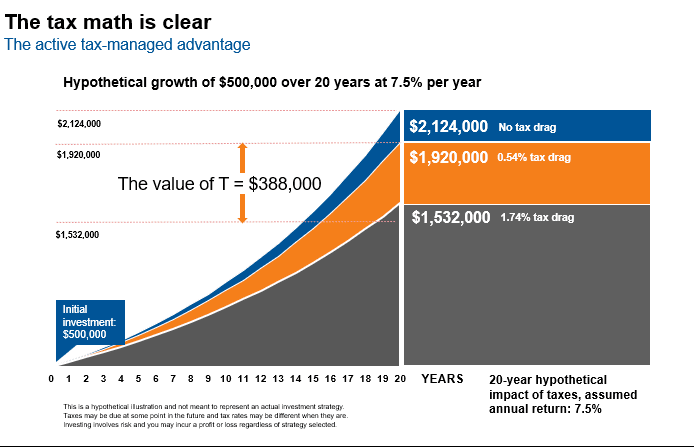by Tom Flynn, Russell Investments
Taxes matter. Imagine your paycheck if income taxes weren’t deducted. Imagine how the price of a car or major appliances or a nice shirt would change if the invoice didn’t include sales or excise taxes.
Many investors don’t realize that the same applies to an investment portfolio.
Taxes are a cost when it comes to investments. They are a drag on a portfolio’s returns. In essence, taxes are like a government fee being applied to investment portfolios.
We believe advisors who take taxes into consideration when constructing an investment portfolio can play a significant role in helping minimize the impact of taxes on their clients. And we believe that has significant value.
This is the fifth and last blog in this year’s Value of an Advisor series, each of them taking a deeper dive into our easy-to-remember formula:
Click image to enlarge
In this blog, we are going to look at the value an advisor can provide when they consider taxes throughout the investment process. We’re not just talking about tax-loss harvesting or capital gains taxes. We’re talking about using tax-loss harvesting as a way to offset the tax impact of realized capital gains. We are talking about minimizing the tax cost of dividends as well as interest payments, carefully timing and managing portfolio turnover and trading activity and maximizing the use of tax-lot level accounting, among other strategies. Even asset location within a portfolio holds the potential to affect after-tax success.
Managing the impact of taxes on a portfolio could take on even greater importance this year as the Biden administration searches for ways to increase revenues to help offset the cost of the support programs related to COVID-19 and other policy goals. Proposals include an increase to the top marginal tax rate, changes to taxes on long-term capital gains and qualified dividends, removing the step-up in basis at death on appreciated assets and taxing carried interest as ordinary income. All could potentially take a bite out of a portfolio’s returns.
Tax-Managed Investing
Help maximize your clients' after-tax wealth.

In the face of this level of uncertainty, advisors who are prepared and help protect their client portfolios from the impact of these potential changes may demonstrate differentiating value.
And there is plenty of opportunity for tax-smart advisors. According to the 2021 ICI Fact Book, taxable investors hold $11.2 trillion of the $29.3 trillion invested in open-ended mutual funds.
Now let’s look at how much difference you can make for those investors by being a tax-smart advisor. We’ve created a tax impact comparison tool. Just enter a ticker symbol and the tool will allow you to compare investment solutions on a tax-adjusted basis and quickly assess the tax implication between products and categories. You can also check out the chart below, which gives a quick visual of the potential impact.
Click image to enlarge
Source: Russell Investments. Tax-managed: funds identified by Morningstar to be tax-managed.
Universe averages*: Created table of all U.S. equity mutual funds and ETFs as reported by Morningstar. Calculated arithmetic average for pre-tax, post-tax return for all shares classes as listed by Morningstar. Morningstar Categories included: U.S. ETF Large Blend, U.S. ETF Large Growth, U.S. ETF Large Value, U.S. ETF Mid-Cap Blend, U.S. ETF Mid-Cap Growth, U.S. ETF Mid-Cap Value, U.S. ETF Small Blend, U.S. ETF Small Growth, U.S. ETF Small Value, U.S. OE Large Blend, U.S. OE Large Growth, U.S. OE Large Value, U.S. OE Mid-Cap Blend, U.S. OE Mid-Cap Growth, U.S. OE Mid-Cap Value, U.S. OE Small Blend, U.S. OE Small Growth, U.S. OE Small Value.
There is also a potential long-term advantage of being tax-smart when investing. As you can see from the chart below, removing the tax drag can substantially impact a portfolio’s return. We believe that advisors who help their clients maximize their after-tax returns can potentially add meaningful value.
'Click image to enlarge
This is a hypothetical illustration and not meant to represent an actual investment strategy. Taxes may be due at some point in the future and tax rates may be different when they are. Investing involves risk and you may incur a profit or loss regardless of strategy selected.
We have long championed the value of a tax-managed approach, both to help advisors help their clients and to help advisors differentiate their practices. For advisors who wonder if they are being tax-smart about investing, we encourage them to answer these five questions:
- Do you KNOW each client’s marginal tax rate?
- Do you PROVIDE intentionally different investment solutions for taxable and non-taxable assets?
- Do you EXPLAIN to clients the benefits of managing taxes?
- Do you PARTNER with local CPAs to minimize tax drag?
- Do you REVIEW your client’s 1099?
We all know the historic government stimulus packages that got us through the COVID-19 pandemic will have to be paid for someday. What we don’t know is which of the tax proposals brought by the new administration will be approved, nor in what form. Still, it’s most likely that taxes are going to go up.
So don’t wait to get tax-smart. Even without tax changes on the horizon, many funds are hit by big capital gains distributions every year. There are steps you can take now to minimize the impact of those distributions. That could represent a significant savings for many of your clients.
Communicate your value
This is the final installment of our 2021 Value of an Advisor series. Unless advisors communicate the value they provide, their clients may not be fully aware of all the benefits they receive by working with an advisor. After all, your value is only as good as the client experience that you are reliably delivering, clearly communicating and constantly elevating.
So then, what are you going to do to elevate your value? A tax-smart approach might be your best place to start. We are ready whenever you are.
To learn more about the 2021 Value of an Advisor Study, click here.
*Methodology for Universe Construction on Tax Drag chart: From Morningstar, extract U.S. equity and fixed income mutual fund and ETF’s for reported period. Averages calculated on a given category. For example, average after-tax return for the large cap category reflects a simple arithmetic average of the returns for all funds that were assigned to the large cap category as of the end date run. For funds with multiple share classes, each share class is counted as a separate “fund” for the purpose of creating category averages. Morningstar category averages include every type of share class available in Morningstar’s database. Large Cap/Small Cap/Municipal Bond determines based upon Morningstar Category. If fund is indicated Morningstar as passive or an ETF, the fund is considered to be passively managed. Otherwise, the fund is considered to be actively managed. Tax Drag: Pre-tax return Less After-Tax Return (pre-liquidation).
Copyright © Russell Investments


















